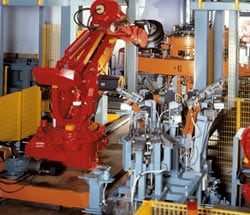During a trip to Pirelli's facilities in Europe, several members of the Tire Rack team had the opportunity to visit their tire plant in Brueberg, Germany. Opened in 1963, this tire manufacturing facility is unique because it now features multiple generations of tire manufacturing equipment within its walls, including Pirelli's latest MIRS (Modular Integrated Robotized System).
Tire manufacturing began as a manpower-intensive process that required skilled operators and large machines to assemble the dozens of components used to produce a tire. Typical tire factories have grown to over a million feet under roof and each tire requires extensive setup to change from one type or size to another.
The Pirelli Modular Integrated Robotized System (MIRS) has changed that. MIRS reduces Pirelli's 14 traditional phases of tire construction to just three: preparation of semi-finished components, building/curing and finishing.
The first thing you notice about a MIRS module is its size. Requiring less than 4,000 square feet of floor space, the entire production process is concentrated in an extremely small area. Little space is required for the preparing or staging of raw materials as they are transformed into finished product without interruption.
The next thing is the precision of the robots as they carry out their computer-choreographed tasks. Beginning with a bare metal drum custom-made for each specific size and type of tire, the robots precisely place the required rubber, fabric and steel components onto the drum. Since many of these components are applied spirally as the drum rotates, the finished tire is extremely consistent and uniform.
As each robot completes its job, the partially completed tire is handed off to the next robot to add the next components. After all the robots have completed their assigned manufacturing tasks, the tires are cured in segmented molds circulating on a multi-position carrousel specifically designed for MIRS manufacturing. A MIRS module completes curing a tire every three minutes and each tire's balance and uniformity is confirmed before it moves on to final inspection.
For a process that was once manpower intensive, it's interesting to note that the first time a MIRS tire is touched by human hands is after it has completed the manufacturing process. This is when a Pirelli technician inspects it for cosmetic flaws before sending it to the warehouse to begin its journey to vehicle manufacturers or tire dealers around the world.
The next important capability provided by MIRS is its flexibility. With the number of tires sizes continually increasing, and many of which combining low profiles, large rim diameters and lower annual volumes, they can't be produced efficiently in a standard factory. One of the advantages MIRS offers is as long as the basic plies, belts and compounds remain the same, MIRS programming allows it to manufacturer multiple sizes without missing a beat. Also, Pirelli's extended mobility solution is made possible by the MIRS computer-controlled robotized manufacturing system, which assures consistency in the application of the additional sidewall reinforcements that provide the self-supporting run-flat capability.
Compared to the traditional, large-scale manufacturing systems with high-volume production rates, a MIRS module is a compact production "island" that masters low volume runs and can be programmed for extremely rapid adaptation to the production of new tire models. Pirelli has truly blended creativity and technology in their Modular Integrated Robotized System.
YOU FOUND THIS POST HELPFUL.
388 of 687 people found this post helpful



